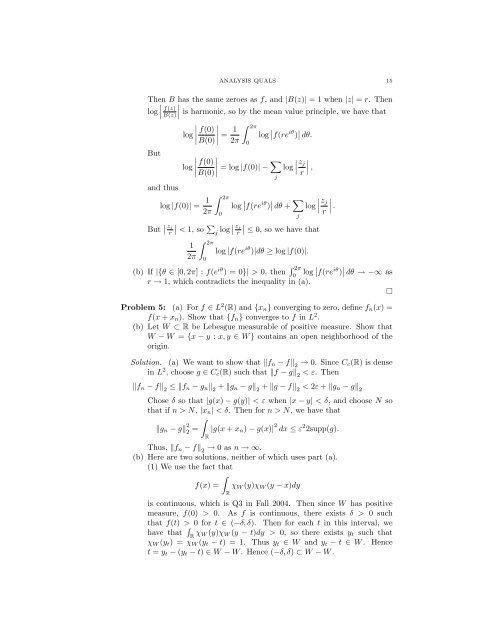ANALYSIS QUALIFYING EXAM PROBLEMS BRIAN LEARY ...
ANALYSIS QUALIFYING EXAM PROBLEMS BRIAN LEARY ...
ANALYSIS QUALIFYING EXAM PROBLEMS BRIAN LEARY ...
Create successful ePaper yourself
Turn your PDF publications into a flip-book with our unique Google optimized e-Paper software.
<strong>ANALYSIS</strong> QUALS 15<br />
Then B has the same zeroes as f, and |B(z)| = 1 when |z| = r. Then<br />
<br />
log f(z)<br />
<br />
<br />
B(z) is harmonic, so by the mean value principle, we have that<br />
<br />
<br />
log <br />
f(0) <br />
2π<br />
<br />
1<br />
B(0)<br />
= log<br />
2π<br />
<br />
iθ<br />
f(re ) dθ.<br />
But<br />
0<br />
<br />
<br />
log <br />
f(0) <br />
<br />
<br />
<br />
B(0)<br />
= log |f(0)| − log zj<br />
<br />
<br />
,<br />
r<br />
and thus<br />
log |f(0)| = 1<br />
2π<br />
log<br />
2π 0<br />
f(re iθ ) dθ + <br />
<br />
log<br />
j<br />
But zj <br />
<br />
r < 1, so <br />
j log zj <br />
<br />
r ≤ 0, so we have that<br />
1<br />
2π<br />
2π<br />
0<br />
log |f(re iθ )|dθ ≥ log |f(0)|.<br />
j<br />
<br />
<br />
.<br />
r<br />
(b) If |{θ ∈ [0, 2π] : f(e iθ ) = 0}| > 0, then 2π<br />
0 log f(re iθ ) dθ → −∞ as<br />
r → 1, which contradicts the inequality in (a).<br />
<br />
Problem 5: (a) For f ∈ L 2 (R) and {xn} converging to zero, define fn(x) =<br />
f(x + xn). Show that {fn} converges to f in L 2 .<br />
(b) Let W ⊂ R be Lebesgue measurable of positive measure. Show that<br />
W − W = {x − y : x, y ∈ W } contains an open neighborhood of the<br />
origin.<br />
Solution. (a) We want to show that fn − f 2 → 0. Since Cc(R) is dense<br />
in L 2 , choose g ∈ Cc(R) such that f − g 2 < ε. Then<br />
fn − f 2 ≤ fn − gn 2 + gn − g 2 + g − f 2 < 2ε + gn − g 2<br />
Chose δ so that |g(x) − g(y)| < ε when |x − y| < δ, and choose N so<br />
that if n > N, |xn| < δ. Then for n > N, we have that<br />
<br />
gn − g 2<br />
2 =<br />
zj<br />
|g(x + xn) − g(x)|<br />
R<br />
2 dx ≤ ε 2 2supp(g).<br />
Thus, fn − f2 → 0 as n → ∞.<br />
(b) Here are two solutions, neither of which uses part (a).<br />
(1) We use the fact that<br />
<br />
f(x) = χW (y)χW (y − x)dy<br />
R<br />
is continuous, which is Q3 in Fall 2004. Then since W has positive<br />
measure, f(0) > 0. As f is continuous, there exists δ > 0 such<br />
that f(t) > 0 for t ∈ (−δ, δ). Then for each t in this interval, we<br />
have that <br />
R χW (y)χW (y − t)dy > 0, so there exists yt such that<br />
χW (yt) = χW (yt − t) = 1. Thus yt ∈ W and yt − t ∈ W . Hence<br />
t = yt − (yt − t) ∈ W − W . Hence (−δ, δ) ⊂ W − W .
















